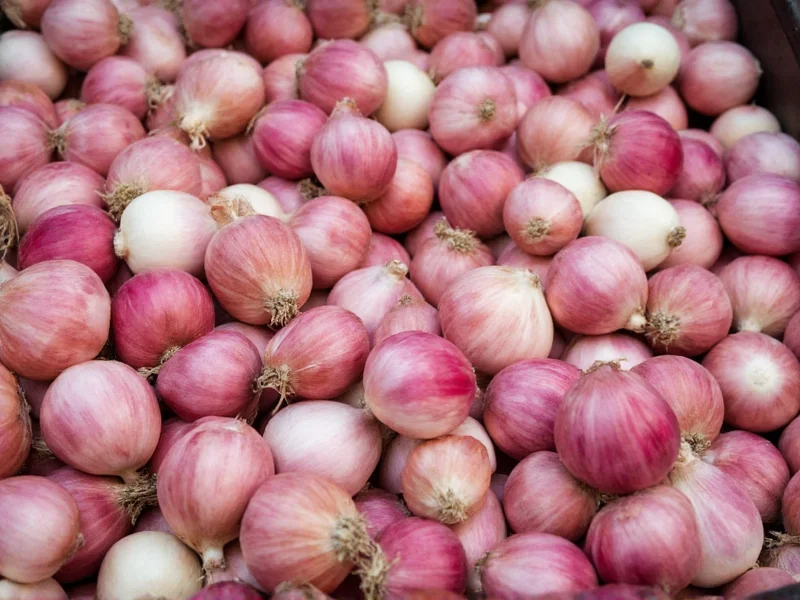Shallots are a kitchen staple prized for their delicate flavor, but improper storage can lead to premature spoilage, mold, or sprouting. Understanding the best storage for shallots ensures you maximize their shelf life and maintain optimal flavor for your cooking.
The Science Behind Proper Shallot Storage
Unlike many vegetables that benefit from refrigeration, shallots are members of the Allium family (along with onions and garlic) that thrive in dry, cool environments. The key to how to store shallots long term lies in controlling three critical factors: moisture, temperature, and airflow.
Shallots naturally contain high moisture content. When exposed to additional humidity (like that found in refrigerators), they begin to deteriorate rapidly. The ideal storage environment maintains low humidity while allowing for proper air circulation around each bulb.
Step-by-Step Guide to Storing Shallots
Follow these simple steps for the proper shallot storage methods that will keep your shallots fresh for weeks:
- Choose quality shallots: Select firm bulbs with dry, papery skins and no signs of mold or soft spots
- Avoid washing: Never wash shallots before storage as moisture accelerates spoilage
- Cure if necessary: If recently harvested, cure shallots in a warm, dry place for 2-3 weeks
- Remove excess dirt: Gently brush off soil without damaging the outer skin
- Select proper container: Use mesh bags, woven baskets, or paper bags with ventilation
- Store in ideal location: Place in a cool, dark pantry or cabinet away from heat sources
- Check periodically: Inspect weekly and remove any that show signs of spoilage
Common Shallot Storage Mistakes to Avoid
Many home cooks make these critical errors when trying to figure out where to store shallots in kitchen spaces:
- Refrigerating whole shallots: The high moisture environment causes them to become mushy and develop mold
- Storing near potatoes: Potatoes emit moisture and gases that accelerate shallot sprouting
- Using sealed plastic bags: Traps moisture and creates a breeding ground for mold
- Leaving in original grocery netting: Often too loose, allowing too much light exposure
- Storing in direct sunlight: Causes premature sprouting and flavor degradation
| Storage Method | Expected Shelf Life | Quality Preservation | Common Issues |
|---|---|---|---|
| Cool, dark pantry (55-65°F/13-18°C) | 4-8 weeks | Excellent | None when done properly |
| Refrigerator (whole) | 2-3 weeks | Poor (becomes mushy) | Mold development, texture loss |
| Room temperature (warm) | 2-3 weeks | Fair | Sprouting, drying out |
| Freezer (chopped) | 6-12 months | Good for cooking | Texture changes, best for cooked dishes |
| Pantry with potatoes | 2-3 weeks | Poor | Accelerated sprouting |
How to Tell If Shallots Have Gone Bad
Knowing how to keep shallots from sprouting and when they've spoiled is crucial for food safety. Discard shallots showing any of these signs:
- Soft or mushy spots: Indicates internal decay
- Mold growth: Any visible fuzzy spots (white, green, or black)
- Unpleasant odor: Sour or ammonia-like smell
- Excessive sprouting: While small sprouts can be cut off, extensive sprouting indicates deterioration
- Wrinkled appearance: Severe wrinkling beyond normal drying
Special Storage Situations
Storing Cut Shallots
Once cut, shallots require different handling. Place chopped shallots in an airtight container in the refrigerator and use within 7-10 days. For longer storage, freeze chopped shallots on a baking sheet before transferring to freezer bags.
Dealing With Sprouting Shallots
If your shallots begin sprouting, don't panic. Small green shoots can be trimmed off, and the bulb remains edible. However, extensive sprouting indicates the shallot is using its energy reserves, which affects flavor and texture. Use sprouted shallots promptly.
Freezing Shallots for Long-Term Storage
For how to store shallots long term beyond their natural shelf life, freezing is an excellent option:
- Peel and chop shallots
- Spread on baking sheet and freeze until solid
- Transfer to labeled freezer bags, removing excess air
- Use within 12 months for best quality
Freezing changes the texture, making frozen shallots best for cooked dishes rather than raw applications.
Frequently Asked Questions
Can you refrigerate shallots for longer storage?
No, refrigerating whole shallots is not recommended as the moisture in the refrigerator causes them to spoil faster. The cold, humid environment makes shallots absorb moisture, leading to mold growth and a mushy texture. Store shallots at room temperature in a cool, dark place instead.
How long do properly stored shallots last?
When stored properly in a cool, dark, dry place with good air circulation, shallots can last 1-2 months. The exact shelf life depends on the initial quality of the shallots and how consistently you maintain the ideal storage conditions of 55-65°F (13-18°C) with low humidity.
Why shouldn't you store shallots with potatoes?
You shouldn't store shallots with potatoes because potatoes emit moisture and ethylene gas, which accelerates the sprouting process in shallots and other alliums. This dramatically reduces the shelf life of your shallots. Store these items separately for optimal freshness.
What's the best container for storing shallots?
The best containers for storing shallots provide excellent air circulation while protecting from light. Mesh bags, woven baskets, or paper bags with ventilation holes work best. Avoid plastic bags or airtight containers, which trap moisture and promote mold growth. The traditional brown paper bag is an excellent, accessible option for home storage.











 浙公网安备
33010002000092号
浙公网安备
33010002000092号 浙B2-20120091-4
浙B2-20120091-4